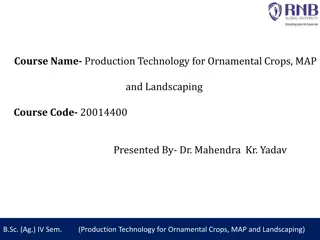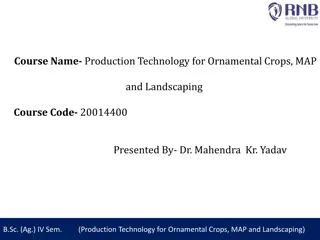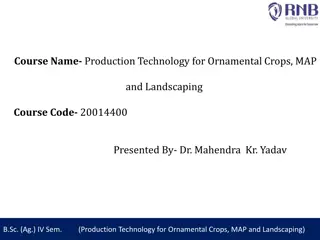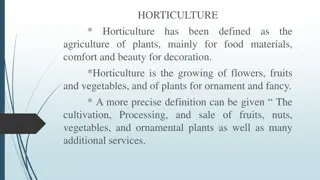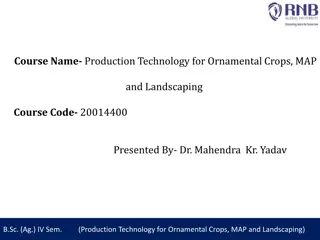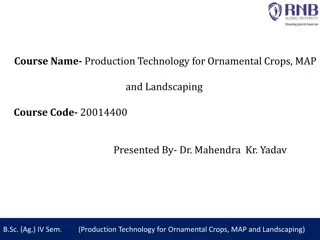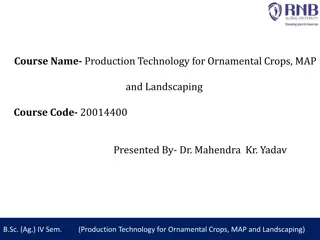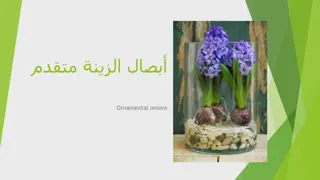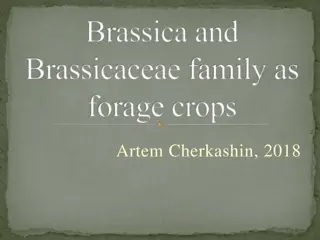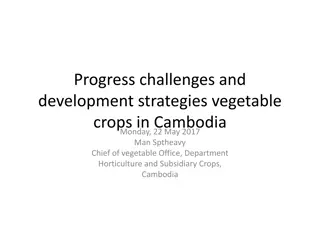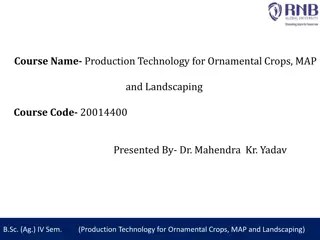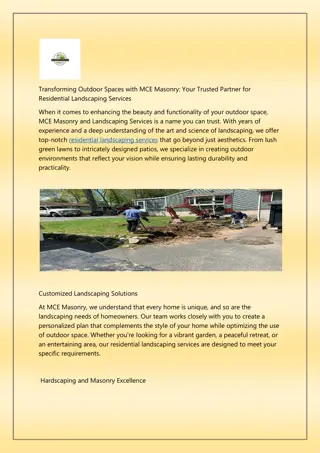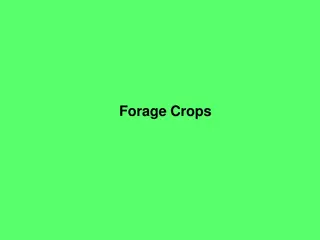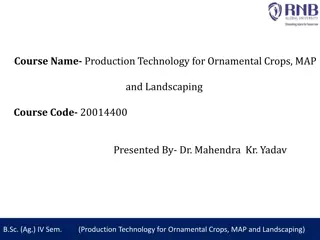Production Technology for Ornamental Crops and Landscaping Course Overview
This course provides an in-depth study of ornamental and medicinal crops, landscaping principles, production technologies, and processing methods. It covers identifying different crop types, packaging practices for flowers, cultivation techniques like protected cultivation of Carnation, and the significance of value addition in ornamental crops. The course also explores the importance and uses of Carnation, popular cultivars, and essential environmental factors for successful production.
Download Presentation

Please find below an Image/Link to download the presentation.
The content on the website is provided AS IS for your information and personal use only. It may not be sold, licensed, or shared on other websites without obtaining consent from the author.If you encounter any issues during the download, it is possible that the publisher has removed the file from their server.
You are allowed to download the files provided on this website for personal or commercial use, subject to the condition that they are used lawfully. All files are the property of their respective owners.
The content on the website is provided AS IS for your information and personal use only. It may not be sold, licensed, or shared on other websites without obtaining consent from the author.
E N D
Presentation Transcript
Course Name- Production Technology for Ornamental Crops, MAP and Landscaping Course Code- 20014400 Presented By- Dr. Mahendra Kr. Yadav B.Sc. (Ag.) IV Sem. (Production Technology for Ornamental Crops, MAP and Landscaping)
Course Objectives Identify different types of ornamental and medicinal crops. Examine various principles of landscaping, uses of landscape trees, shrubs and climbers, production technology of important ornamental crops, etc. Determine about Demonstrate various Package of practices for loose flowers and their transportation, storage house and required condition for cut and loose flower. Construct about the various problems with the production technology of medicinal and aromatic plants. Importance of Processing and value addition in ornamental crops and MAPs produce. B.Sc. (Ag.) IV Sem. (Production Technology for Ornamental Crops, MAP and Landscaping)
Protected cultivation of Carnation B.Sc. (Ag.) IV Sem. (Production Technology for Ornamental Crops, MAP and Landscaping)
INTRODUCTION Common name: Carnation Scientific name: Dianthus spp. Family: Caryophyllaceae Chromosome no: 2n=30 B.Sc. (Ag.) IV Sem. (Production Technology for Ornamental Crops, MAP and Landscaping)
IMPORTANCEAND USES Cut flowers Border crop Rock gardens Perfumes Volatile oil B.Sc. (Ag.) IV Sem. (Production Technology for Ornamental Crops, MAP and Landscaping)
POPULAR CARNATION CULTIVARS Dona, Pink Dona, Malaga, White Dona, Rony, Rhodos, Lipstick, Empire, Romana, White Tendra, Corleone, Design, Natila, Dark Tempo, Bagatel silvery pink, Solar, Cobra, Pendy, Lorella, Cabaret, Tanga, Sonsara, Dakar, Liberty, Solar, Green Lady, Tempo, Varna, Sun Shine and Charment B.Sc. (Ag.) IV Sem. (Production Technology for Ornamental Crops, MAP and Landscaping)
ENVIRONMENTALFACTORS Light: Photoperiod (long days over 16 hours) Intensity: (100 watts bulb spaced at 10.5 m at 1.5 m height) TEMPERATURE Night (winter: 10-110C, spring: 12.70C and summer: 13- 15.40C) and day ( 18-230C) Ventilation: Free circulation of air Relative humidity: 50-60%. CO2: 500-1500 ppm B.Sc. (Ag.) IV Sem. (Production Technology for Ornamental Crops, MAP and Landscaping)
SOILAND GROWING MEDIUM Light texture loam or sandy loam soil which is well drained and aerated. Soil pH: 6-7. PLANTING TIME: N.I. plains: Sep.-Oct. Low hills: Sep.-Nov. Mid hills: Jan.-Feb. High hills: Mar.-April Staggered planting at 15 days interval ensure regular supply of cut flowers. B.Sc. (Ag.) IV Sem. (Production Technology for Ornamental Crops, MAP and Landscaping)
PROPAGATION Terminal stem cuttings (8-10 cm long with 4-6 leaf pairs) Micro-propagation PLANTING DENSITYAND SPACING Ordinary: 25-32 plants/m2 High : 40 plants/m2 Standards: 20 x 20 cm B.Sc. (Ag.) IV Sem. (Production Technology for Ornamental Crops, MAP and Landscaping)
SPRAY OPTIMUM NUTRITION N: 5.4%, P: 0.31%, K: 3.8%. For Standards: FYM: 5 kg, N: 30g, P: 20g, K: 10g/m2 For Spray: FYM: 5 kg, N: 40g, P: 20g, K: 10g/m2 Now commercially nutrition is given through fertigation. B.Sc. (Ag.) IV Sem. (Production Technology for Ornamental Crops, MAP and Landscaping)
Soil moisture and irrigation: Optimum soil moisture is 300-500 cm tension. Irrigation is done through drip irrigation with three lines in five rows in a bed. Daily water requirement varies with the outside temperature from 2 to 3 litres/m2. Water soluble fertilizers are also given along with irrigation. During vegetative phase irrigation through sprinkler/ mister/ fogger is beneficial. B.Sc. (Ag.) IV Sem. (Production Technology for Ornamental Crops, MAP and Landscaping)
Pinching: In pinching terminal growing shoot about 2-3 cm removed to overcome apical dominance and branching when the plants are at 6-8 leaf pair stage. long is to promote side B.Sc. (Ag.) IV Sem. (Production Technology for Ornamental Crops, MAP and Landscaping)
Pinching types: Single Pinch and half Pinch plus pull pinch Double B.Sc. (Ag.) IV Sem. (Production Technology for Ornamental Crops, MAP and Landscaping)
De-shooting: When the side shoots after pinching are 3-5 cm long then retain 3-5 shoots per plant in standard cultivars. When the side shoots after pinching are 3-5 cm long then retain 6-10 shoots per plant in spray cultivars. B.Sc. (Ag.) IV Sem. (Production Technology for Ornamental Crops, MAP and Landscaping)
Staking: Wire mesh, plastic nets, string or bamboo canes are support plants. used to Wire mesh or plastic nets having inner size of 10-15 are placed on the ground in three layers, which are erected at 20, 35 and 50 cm above the ground level with the growing plants. cm squares String or rope is erected in three rows at the same along the rows. distance B.Sc. (Ag.) IV Sem. (Production Technology for Ornamental Crops, MAP and Landscaping)
Disbudding: Disbudding is the removal of visible (5-10 mm diameter) undesirable buds. In standard cultivars terminal bud is retained and all the lateral buds are removed. In spray cultivars terminal bud is removed and lateral buds are retained. B.Sc. (Ag.) IV Sem. (Production Technology for Ornamental Crops, MAP and Landscaping)
WEEDING Three-four hand weeding. Chemicals viz., oxidiazon and napropamide @ 2.2 and 4.5 kg a.i. per hectare are good in greenhouse. In open fluchloralin (basalin) and pendimethalin (stomp) @ 1.0 a.i. per hectare each are effective. B.Sc. (Ag.) IV Sem. (Production Technology for Ornamental Crops, MAP and Landscaping)
Stages of flower harvesting: Standard cultivars- for local market are harvested when flowers are half opened or at painting brush or outer petal is perpendicular to stem. while for distant market cross is developed on buds and colour is visible. Spray cultivars are harvested for local market when two flowers have opened and others have shown colour, while for distant market when 50% flowers have shown colour. B.Sc. (Ag.) IV Sem. (Production Technology for Ornamental Crops, MAP and Landscaping)
COMMON GRADES IN INDIA A: over 45 cm B: 30-45 cm C: less than 30 cm B.Sc. (Ag.) IV Sem. (Production Technology for Ornamental Crops, MAP and Landscaping)
PACKAGING In bundles of 10,12, 20 or 25. In corrugated card board boxes of 120 x 60 x 30 cm (L x W x H) accommodates about 800-1000 cut flowers of carnation. Wrap flower bunches in cellophane sleeves. B.Sc. (Ag.) IV Sem. (Production Technology for Ornamental Crops, MAP and Landscaping)
DISEASES Wilt (Fusarium oxysporum f. sp. dianthi) Foot- rot (Phytophthora, Pythium, Rhizoctonia solani, Sclerotinia sclerotiarum) Stem rot (Fusarium roseum) Flower bud rot (Alternaria dianthi) B.Sc. (Ag.) IV Sem. (Production Technology for Ornamental Crops, MAP and Landscaping)
Contd Bacterial wilt (Pseudomonas caryophylli) Rust (Uromyces caryophyllinus or U. dianthi) Flower blight (Botrytis cinerea) Fairy ring spot (Heterosporium echinulatum) Viral dseiases B.Sc. (Ag.) IV Sem. (Production Technology for Ornamental Crops, MAP and Landscaping)
INSECT-PESTS Red spider mites Thrips Nematodes Aphids Helicoverpa/ Heliothis/Spodoptera caterpillars B.Sc. (Ag.) IV Sem. (Production Technology for Ornamental Crops, MAP and Landscaping)
PHYSIOLOGICALDISORDERS Calyx splitting Grassiness Sleepiness Splitting at nodes and bushiness Calyx splitting B.Sc. (Ag.) IV Sem. (Production Technology for Ornamental Crops, MAP and Landscaping)
Tinting in carnation: A concentrated liquid or powder colour is mixed in small amount of warm pure water (37oC) and stems are placed in it. The colour develops in different patterns on the petals after 10-24 hours. B.Sc. (Ag.) IV Sem. (Production Technology for Ornamental Crops, MAP and Landscaping)
YIELD 200-300 flower stems/m2/year. B.Sc. (Ag.) IV Sem. (Production Technology for Ornamental Crops, MAP and Landscaping)
B.Sc. (Ag.) IV Sem. (Production Technology for Ornamental Crops, MAP and Landscaping)







